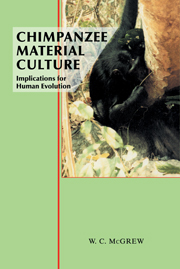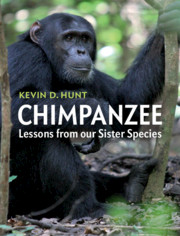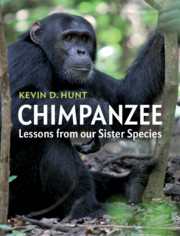Chimpanzee Material Culture
The chimpanzee of all other living species is our closest relation, with whom we last shared a common ancestor about five million years ago. These African apes make and use a rich and varied kit of tools, and of the primates they are the only consistent and habitual tool-users and tool-makers. Chimpanzees meet the criteria of a culture as originally defined for human beings by socio-cultural anthropologists. They show sex differences in using tools to obtain and to process a variety of plant and animal foods. The technological gap between chimpanzees and human societies that live by foraging (hunter-gatherers) is surprisingly narrow at least for food-getting. Different communities of wild chimpanzees have different tool-kits and not all of this regional and local variation can be explained by the demands of the physical and biotic environments in which they live. Some differences are likely to be customs based on socially derived and symbolically encoded traditions.
This book describes and analyzes the tool-use of humankind's nearest living relation. It focuses on field studies of these apes across Africa, comparing their customs to see if they can justifiably be termed cultural. It makes direct comparisons with the material culture of human foraging peoples. The book evaluates the chimpanzee as an evolutionary model, showing that chimpanzee behavior helps us to infer the origins of technology in human prehistory.
- The chimpanzee is humankind's nearest living relative
- An understanding of chimpanzee behaviour helps us to infer the origins of technology in human prehistory
- Of interest to a wide range of disciplines: animal behaviour, psychology, anthropology, archaeology
Reviews & endorsements
"...an important contribution both to our understanding of chimpanzee behavior (it provides the first critical synthesis of a widely scattered literature of very variable quality) and to our understanding of the process of hominization. It will be particularly valuable if it persuades social scientists to take the work of primatologists and other animal biologists more seriously." R.I.M. Dunbar, Nature
"...a comprehensive synthesis of chimpanzee material culture...." Sanjida O'Connell, New Scientist
"This book is as fascinating for its methodology and its questions as for the remarkable observations it gathers. Overall it strengthens, in spite of itself, the popular bias of our times: hominid culture grew not from routine tool use but out of new software abilities based on new neural hardware. It is the combinatorial richness of blossoming language that will be hardest to sift out of the ash layer of the Rift." Scientific American
"Chimpanzee Material Culture ably fills an enormous gap in the physical anthropologist's bookshelf. In it, William r. McGrew achieves two quite different but equally worthwhile goals. He sets forth a clear, encyclopedic account of tool-use behavior by chimpanzees at sites across Africa (and by other free-ranging apes and captive apes to a lesser extent), then, moving beyond compilation, contributes to anthropological modeling and theory. Topics as diverse as the meaning of culture; significant factors in hominization; and referential vs. conceptual modeling are dealt with in perceptive and thought-provoking ways." Barbara J. King, American Journal of Physical Anthropology
"...masterfully integrates primatology and (paleo)anthropology, scrutinizes diet, food acquisition and processing, and other aspects of chimpanzees' daily life and compares their behaviors with those of other ape species and living hunter-gatherer societies to gain insight into hominization." Elisabetta Visalberghi, Science
"This book is, in a word, elegant. It is clearly conceived, closely reasoned, concisely formulated and cleanly presented...Adroitly interweaving information with interpretation, McGrew focuses sharply on the core issue of cultural overlap in chimpanzee communities and human societies...the work merits special praise for a fluid integration of ideas." Geza Teleki, American Scientist
"A fascinating book..." E. Delson, Choice
"This book is as fascinating for its methodology and its questions as for the remarkable observations it gathers. Overall it strengthens, in spite of itself, the popular bias of our times: hominid culture grew not from routine tool use but out of new software abilities based on new neural hardware. It is the combinatorial richness of blossoming language that will be hardest to sift out of the ash layer of the Rift." Scientific American
"This book is, in a word, elegant. It is clearly conceived, closely reasoned, concisely formulated and cleanly presented...Adroitly interweaving information with interpretation, McGrew focuses sharply on the core issue of cultural overlap in chimpanzee communities and human societies...the work merits special praise for a fluid integration of ideas." Geza Teleki, American Scientist
"...this important volume provides an exquisite review of chimpanzee material "culture." It also raises provocative and researchable evolutionary questions which could keep anthropologists busy for decades to come." Kathleen R. Gibson, Iinternational Journal of Primatology
Product details
November 1992Hardback
9780521413039
296 pages
235 × 157 × 19 mm
0.614kg
77 b/w illus. 36 tables
Available
Table of Contents
- Preface
- 1. Patterns of culture?
- 2. Studying chimpanzees
- 3. Chimpanzees as apes
- 4. Cultured chimpanzees?
- 5. Chimpanzee sexes
- 6. Chimpanzees and foragers
- 7. Chimpanzees compared
- 8. Chimpanzee ethnology
- 9. Chimpanzees as models
- 10. What chimpanzees are, are not, and might be
- References
- Appendix
- Index.








